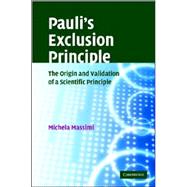
Note: Supplemental materials are not guaranteed with Rental or Used book purchases.
Purchase Benefits
Looking to rent a book? Rent Pauli's Exclusion Principle: The Origin and Validation of a Scientific Principle [ISBN: 9780521839112] for the semester, quarter, and short term or search our site for other textbooks by Michela Massimi. Renting a textbook can save you up to 90% from the cost of buying.
| Note on translation | x | ||||
| Preface | xi | ||||
| Epigraph | xiv | ||||
| Introduction | 1 | (6) | |||
| 1 The exclusion principle: a philosophical overview | 7 | (28) | |||
|
7 | (2) | |||
|
9 | (4) | |||
|
13 | (8) | |||
|
21 | (10) | |||
|
25 | (3) | |||
|
28 | (3) | |||
|
31 | (4) | |||
| 2 The origins of the exclusion principle: an extremely natural prescriptive rule | 35 | (43) | |||
|
35 | (17) | |||
|
35 | (8) | |||
|
43 | (4) | |||
|
47 | (5) | |||
|
52 | (21) | |||
|
52 | (3) | |||
|
55 | (5) | |||
|
60 | (5) | |||
|
65 | (8) | |||
|
73 | (5) | |||
| 3 From the old quantum theory to the new quantum theory: reconsidering Kuhn's incommensurability | 78 | (34) | |||
|
78 | (3) | |||
|
81 | (22) | |||
|
81 | (5) | |||
|
86 | (5) | |||
|
91 | (2) | |||
|
93 | (4) | |||
|
97 | (6) | |||
|
103 | (9) | |||
|
103 | (9) | |||
| 4 How Pauli's rule became the exclusion principle: from Fermi–Dirac statistics to the spin–statistics theorem | 112 | (33) | |||
|
112 | (3) | |||
|
115 | (4) | |||
|
119 | (3) | |||
|
122 | (1) | |||
|
123 | (5) | |||
|
128 | (5) | |||
|
133 | (5) | |||
|
138 | (1) | |||
|
138 | (3) | |||
|
141 | (4) | |||
| 5 The exclusion principle opens up new avenues: from the eightfold way to quantum chromodynamics | 145 | (39) | |||
|
145 | (2) | |||
|
147 | (7) | |||
|
154 | (18) | |||
|
154 | (8) | |||
|
162 | (10) | |||
|
172 | (12) | |||
|
175 | (4) | |||
|
179 | (5) | |||
| Conclusion | 184 | (5) | |||
| References | 189 | (15) | |||
| Index | 204 |
The New copy of this book will include any supplemental materials advertised. Please check the title of the book to determine if it should include any access cards, study guides, lab manuals, CDs, etc.
The Used, Rental and eBook copies of this book are not guaranteed to include any supplemental materials. Typically, only the book itself is included. This is true even if the title states it includes any access cards, study guides, lab manuals, CDs, etc.